A Multimeter, be it a $2,000 calibrated bench meter or a $100 handheld meter, is an important tool for electrical and electronics engineers, technicians, repair personnel, electricians, auto repair works, and many more. Measuring voltage and resistance is very easy but measuring current with a multimeter is little tricky.
You have to make the Multimeter a part of the circuit to make the current flow through it in order to measure the current. Even experienced users sometimes forget to change the probes or set proper mode and burn the meter. This is where Clamp Meters come in handy.
A Clamp Meter is a type of Multimeter that can measure all the parameters as a regular multimeter including current. But instead of using probes, a Clamp Meter measures current with the help of a current sensor (usually a Hall Effect Sensor or a Current Transformer). This way, the user doesn’t have to worry about probes but simply clamp the jaw (that contains the sensor) around a current carrying conductor and measure the current.
We recently got our hands on the KAIWEETS HT208D Inrush Clamp Meter. It can measure both AC and DC Current and as the name suggests, it can also measure the AC Inrush Current.In addition to these, this clamp meter also measures the regular parameters such as voltage, resistance, continuity, diode, capacitor, etc.
This is the review of the KAIWEETS HT208D Inrush Clamp Meter. We are writing this review after using and testing the meter to measure voltage, current, and other important parameters. We alsotested the meter for its ease of use, additional features, and many more. Read along to find out our thoughts and impressions of the same.
Let us start this review by unboxing the KAIWEETS HT208D Clamp Meter. The main package is quite large. Opening the package, we get a large case. It is a hard case and it can easily protect the clamp meter from a fall. We suggest you to keep the meter zipped inside this case when not in use.
Unzipping the case, we have the main event i.e., the KAIWEETS HT208D Clamp Meter on the right side along with a couple of probes.We will come back to the HT208D in a little while. On the left side, we have a thermocouple and a user manual.
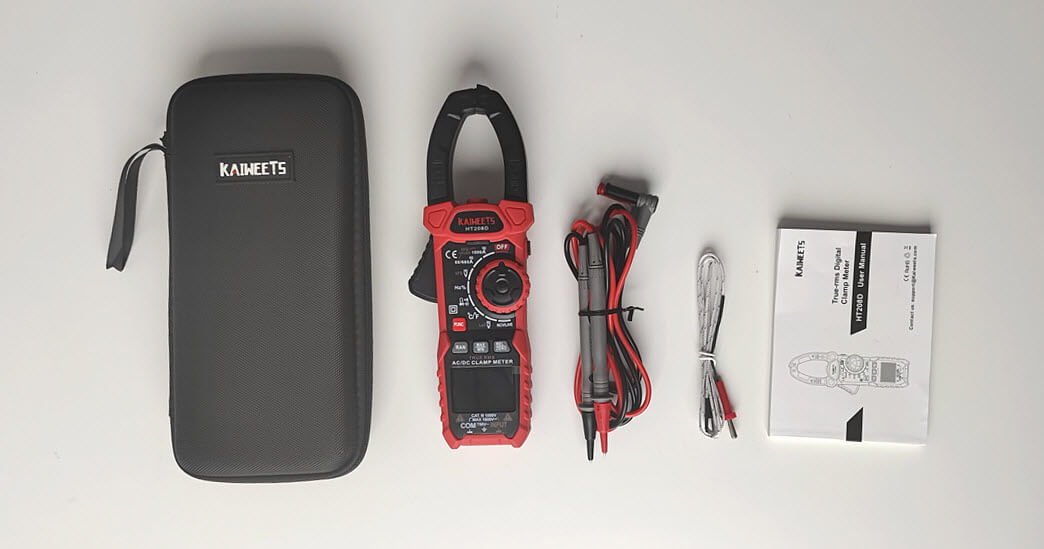
The user manual is very comprehensive with detailed explanation of all the essential measurements and specifications. It includes instruction in English, German, French, Spanish, and Italian. We highly recommend you read the manual before making any measurements. Our unit did not come with batteries.
Coming to the KAIWEETS HT208D Clamp Meter, the initial impressions and in-hand feel are very good. The quality of the material used, buttons, and displayis very good.
On the top, we have the main current sensing jaw that also houses the NCV sensor. The jaw has CATIII 1000V and CAT IV600V markings on it. Also, there is a 1000A MAX warning printed on the jaw.
The jaw release is on the left of the meter. The spring action is very good. There is a tiny flash light on top of the meter. On the right of the meter, there a button that acts as a hold and flash light button (single press to hold or release the value and long press to turn the flash light on or off).
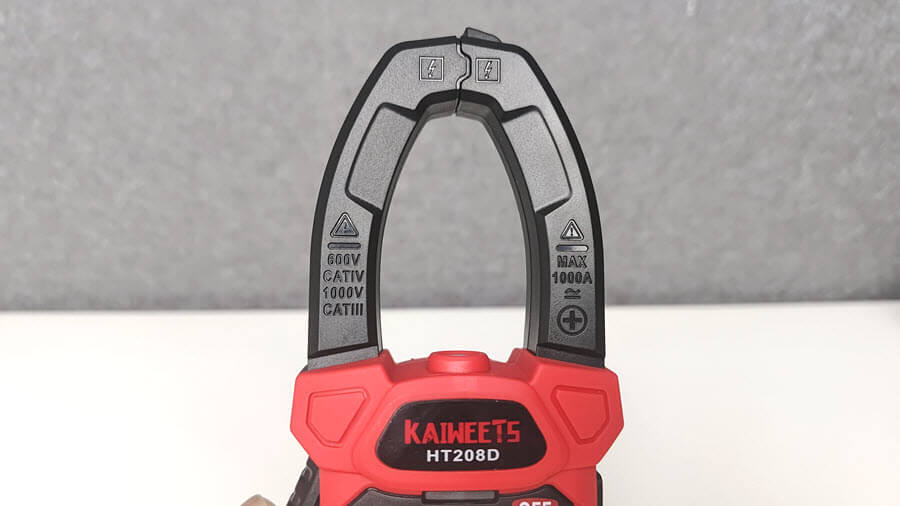
Next is the main control knob of the meter. There is no separate ON/OFF button as the first position of the knob will switch off the meter. Moving the knob to any other position, the meter will turn on and will be ready to measure. Speaking of positions, the knob has 9 positions (including the OFF) to set different modes.
All the positions have clear markings. Next, we have four buttons. The function button will switch between different modes associated with that particular position. The rest of buttons have markings for their operations.
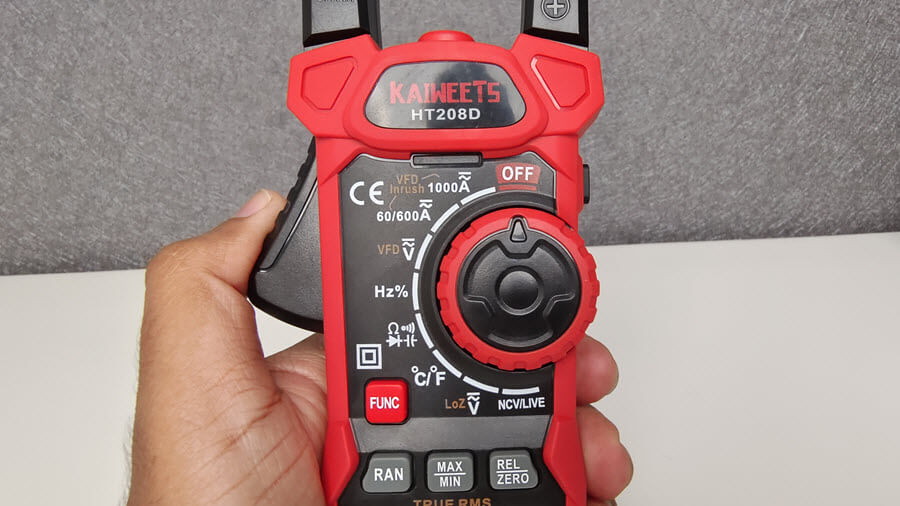
Just below these buttons, we have the display. It is a tiny LCD that displays the readings in white and function/mode symbols in yellow. Even though it is a White on Black display, the viewing angles are decent for indoor usage. However, in outdoor conditions, you might struggle to see the display in some angles. Other than that, the quality of the display is very good.
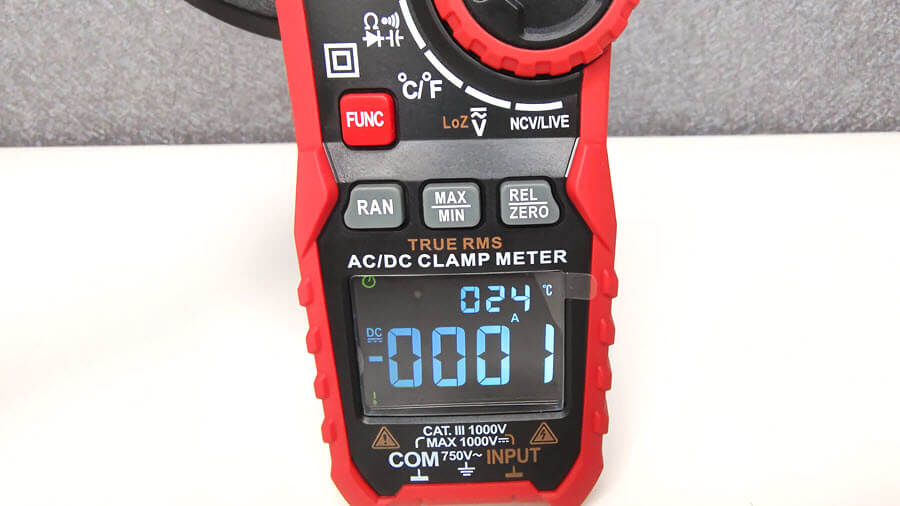
At the bottom, we have a couple of ports to insert the test leads (probes). Sadly, both the ports are red colored. The only way to identify the ports is to look at the marking above (just below the display).
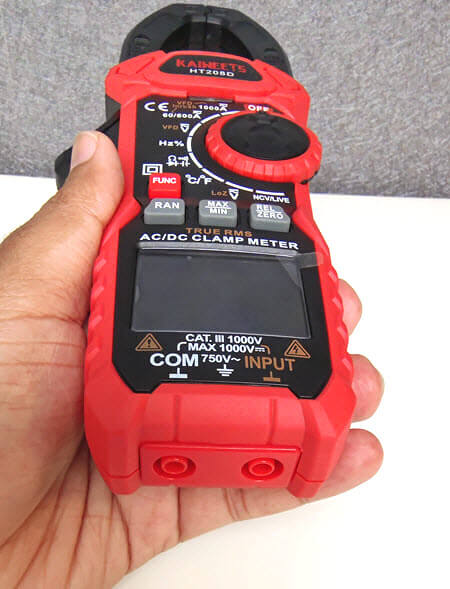
Turning the meter back, we immediately notice couple of slots to hold the probes. This is useful to insert the probes into the slots while measuring AC Mains Voltage near the breaker panel.
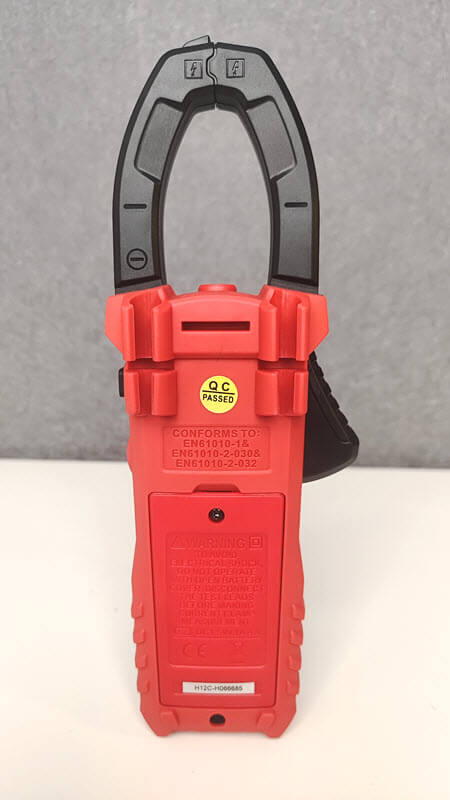
Below that, we have a tiny lid that covers the battery compartment. Speaking of which, you have to unscrew the lid and insert 3 AAA Batteries before making any measurement.

The quality of the probes is very good. Many budget multimeter makers usually skimp on probes but that’s not the case here. Even though the tips aren’t gold platted, the overall quality of the probes is impressive.
There is a K-Type Thermocouple in the kit. We are not sure how many would use it but it is a nice addition to the overall clamp meter experience.
Let us do some testing with the KAIWEETS HT208D Clamp Meter. Before proceeding, you have to insert 3 AAA Batteries in the back.First, we started with measuring voltage. We tested the meter for both AC and DC Voltage and it showed very accurate results. In AC Voltage Measurement, the meter also displays the frequency of the AC Signal, which is 50Hz in case of our mains voltage.
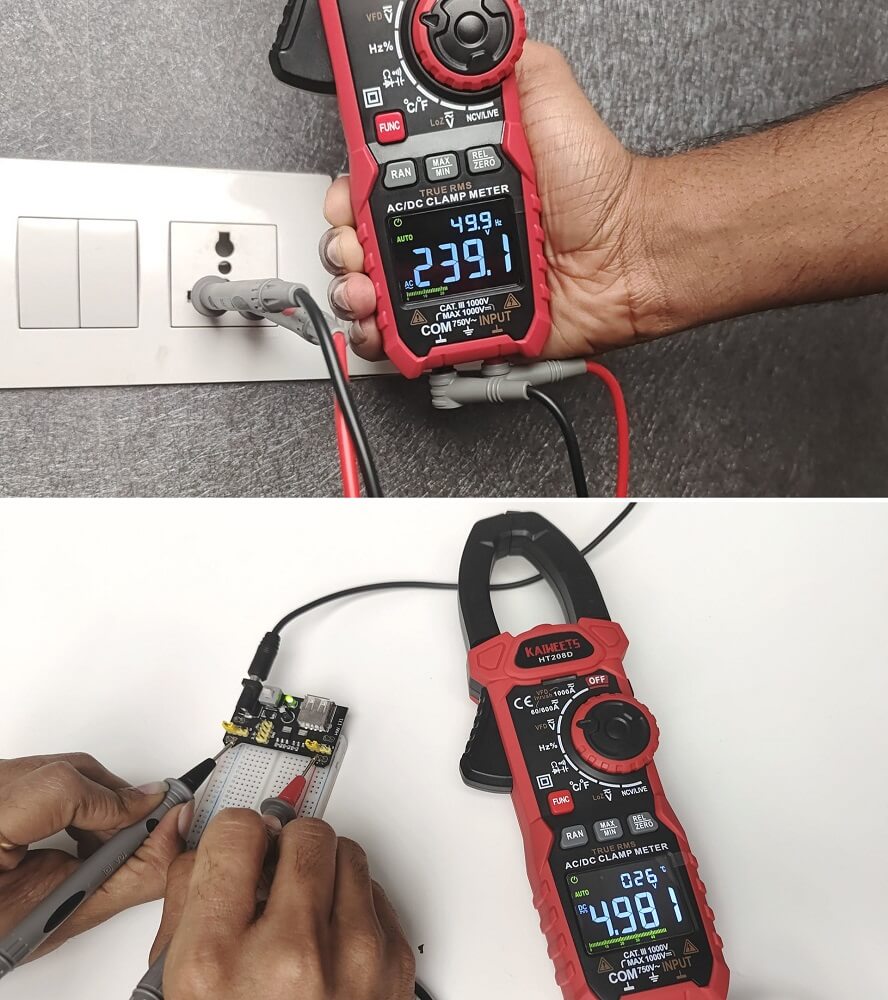
Next, we took a bunch of resistors and potentiometers to see how the meter performs and as expected, it has no problem measuring the resistance. Measuring capacitors is always tricky. We tried to measure slightly higher capacitance and also lower capacitance. Even here, the KAIWEETS HT208D Clamp Meter performed decently.
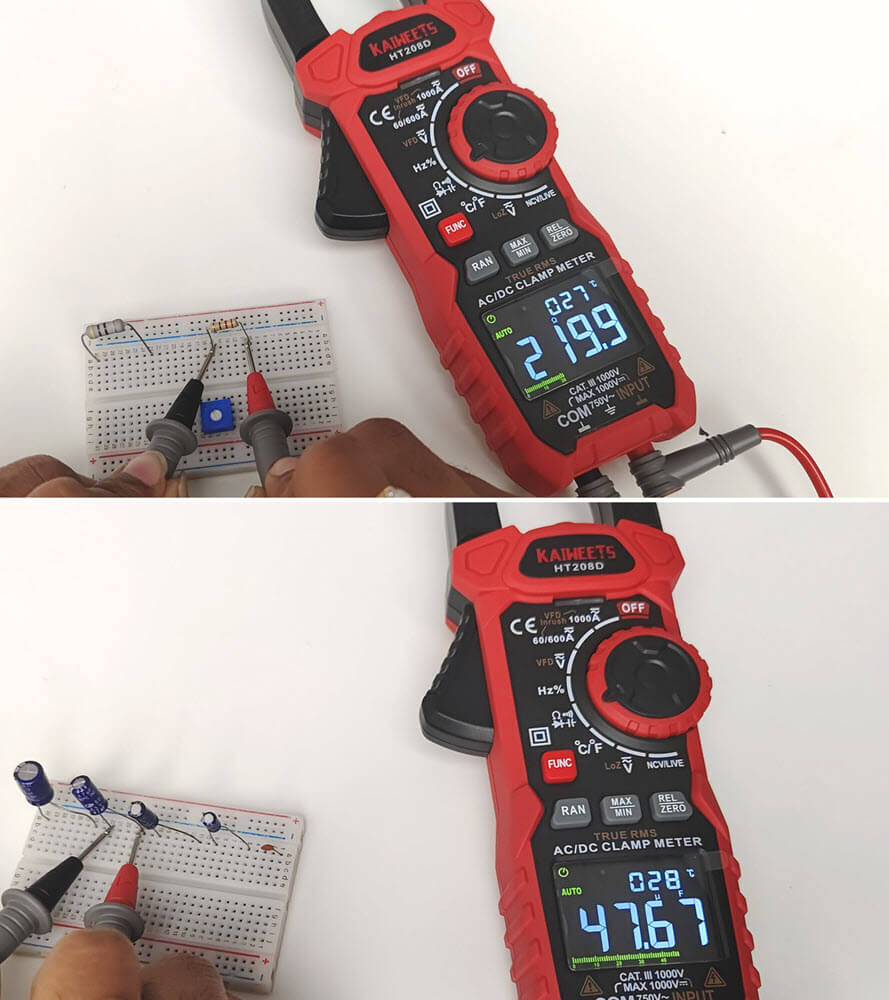
Even though the tips of the probes aren’t gold plated, the response time in direct continuity test is very quick. Another useful function of the HT208D is diode testing. We used the clamp meter in diode mode and tested a bunch of diodes (Regular Diodes, Schottky Diodes, and LEDs).
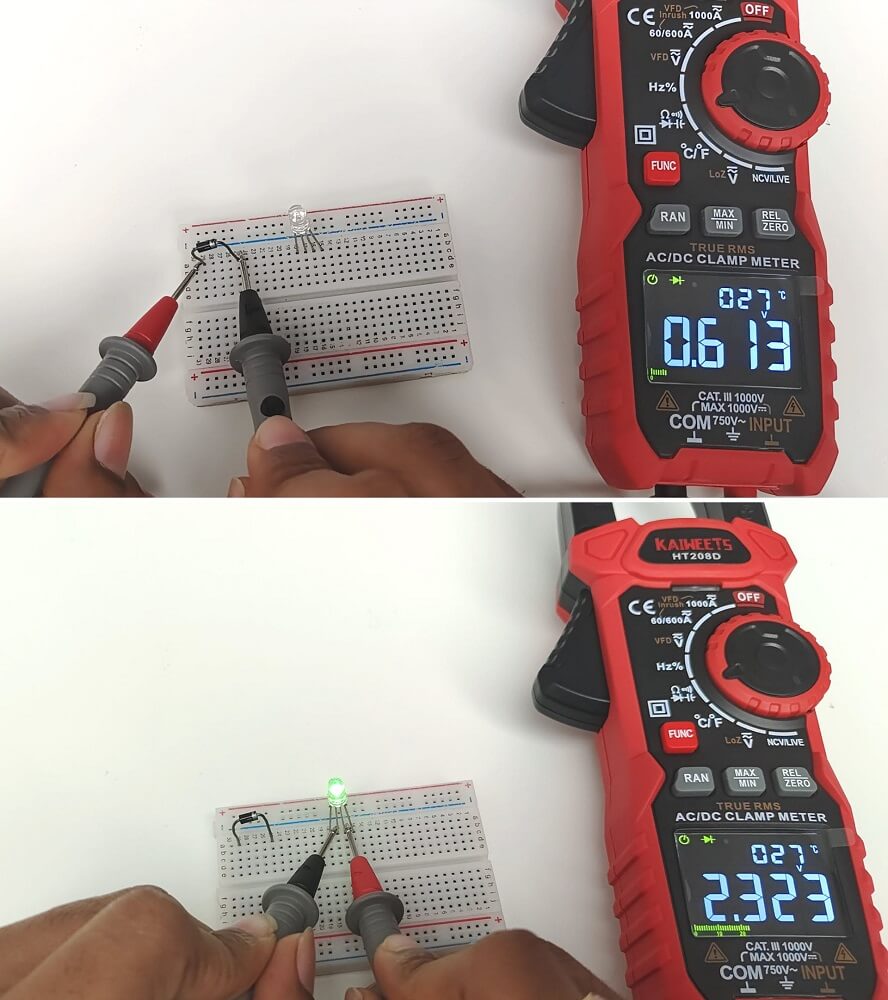
In Diode Testing Mode, the meter outputs 3V and 1.5mA.
Most users who buy a clamp meter generally use it to measure current. So, next up we tried measuring both AC and DC Current. We are extremely happy with results. We took the meter to a small single-phase motor and measured its current. We also measured the inrush currentof this motor. We couldn’t take any pictures as it was outdoors but the performance of the meter is very good.

If you want to use the KAIWEETS HT208D Clamp Meter to measure the Inrush Current of a Motor, note that it takes measurement only for the first 100ms after the motor starts as this is where the current is maximum.
We are in the process of testing a battery-operateddevice that has a motor in it. We were able to accurately measure the current draw of the motor. This helped us in estimating the battery life of the device.
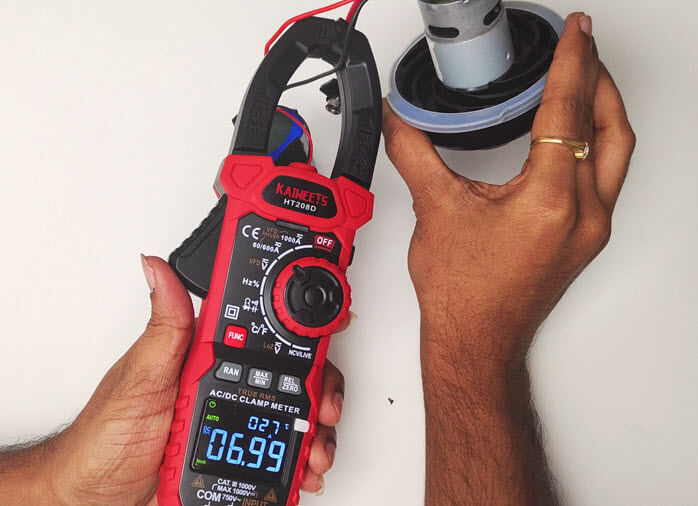
If you want to use this clamp meter to accurately measure the current draw of an appliance, the KAIWEETS HT208D Clamp Meter will definitely do the job.
While the HT208D Clamp Meter is essentially an auto-ranging meter, you can manually set the range for certain modes (voltage, resistance, etc.). You can use the “RAN” button for this purpose.
The MAX/MIN Button does what it says. It displays the maximum or minimum values the meter measured in that mode. Long press the button to exit this mode.
An interesting feature of the KAIWEETS HT208D Clamp Meter is its Low-Impedance Voltage Measurement. In this mode, the internal impedance falls to roughly 300kΩ, which would be 10 MΩ otherwise. If you aren’t familiar with LoZ Mode, the meter lowers its internal resistance to prevent “phantom” voltage measurements. If you are not interested in this feature, then we suggest not to use as wrongful usage can damage the meter.
The K-Type Thermocouple works decently. The meter also has NCV and LIVE AC Voltage detection. While the “Live” voltage works as expected, the NCV measurement is somewhat finicky. It detects voltages near wires and outlets properly but sometimes detects ghost voltages.
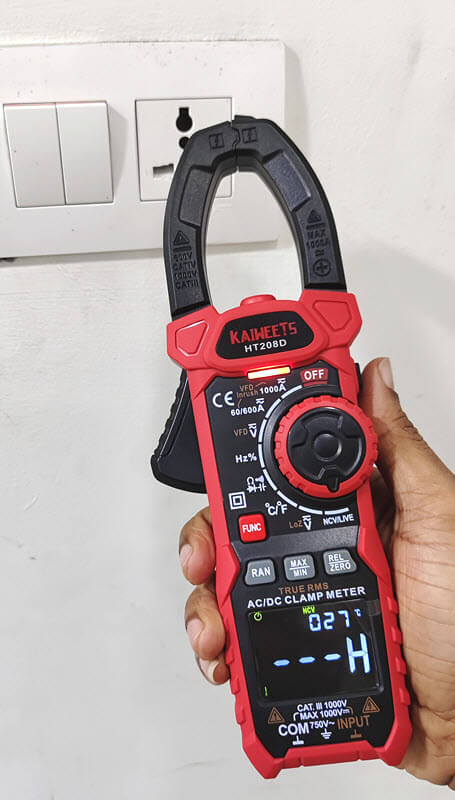
The listing price of the KAIWEETSHT208D Inrush Clamp Meter is $89.99, but the selling price is just $79.99. When you combine the performance, features, and 3-year warranty, we feel that this price tag seems reasonable. Apart from measuring voltage, resistance, continuity, etc., you can measure both AC and DC Current and importantly Inrush AC Current. There are many entry level clamp meters in the market, but we feel that the KAIWEETS HT208D Inrush Clamp Meter stands out in this aspect.
Overall, we are impressed with the design, performance and price of the KAIWEETSHT208DInrush Clamp Meter. It has a solid build quality, excellent in-hand feel, and is very easy to use. While you can measure regular parameters such as Voltage, Resistance, etc., the main purpose of a clamp meter is to measure current and the KAIWEETS HT208D does this with ease.
It can measure both AC and DC Current and as a bonus, it can also measure the AC Inrush Current. It is very rare to find this feature in budget-friendly clamp meters. The provided probes and thermocouple are very good and even the carry case is strong and sturdy.
Apart from a few nitpickings such as same-colored ports and no MOVs for surge voltage protection, the KAIWEETS HT208D Inrush Clamp Meter offers an excellent and accurate performance. If you are in the market for a decent clamp meter for your home usage (home energy auditing, solar energy, battery estimation, etc.), we highly recommend the KAIWEETS HT208D. It’s price and performance are unmatchable with any other clamp meter.
Get great content that you love. No ads or spams, we promise.
Projects
Get great content that you love.
No ads or spams, we promise.
Your Privacy is important to us
Copyright © 2024 Electronicshub.org